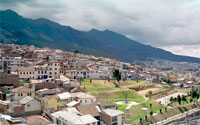
Quito's story begins in the pre-Columbian era, way back before Christopher Columbus and his other European counterparts crossed the Atlantic and changed the face of the New World forever. Prior to the late 15th Century, several tribes lived in the space now occupied by present-day Quito. Among them were the Quitus, from whom Quito derives its name.
The city remained in the hands of indigenous people until 1533, when the advance of Spanish colonialists led to the destruction of the city by its native Inca leader, General Rumiñahui. Counter-intuitive as it may seem for a leader to raze his own capital, he did it nonetheless in order to prevent the Spanish from capturing it.
One year later, however, the Spanish took the city anyway and began the process of rebuilding it. It remained under the control of Spain, in various capacities, until May 24, 1822, "when Antonio José de Sucre, under the command of Simón Bolívar, led troops into the Battle of Pichincha. Their victory marked the independence of Quito and the surrounding areas" (www.en.wikipedia.org).
The modern city of Quito is divided as so many former colonial capitals are: Into an Old City and a New City. In Quito, this division affords visitors the opportunity to experience both the wonders of the Incan and colonial past as well as the promise of the future as one of the most vibrant business centers in modern-day South America.
Quito is home to a breathtaking architectural heritage, especially its ornate churches and cathedrals, many of which feature gold-crusted altars and gorgeous works of art. Situated on Independence Plaza, the Metropolitan Cathedral is a favorite among visitors.
Even the secular architecture is a point of interest, as the influence of the Spanish colonists resulted in homes and neighborhoods featuring the same style of buildings that made Spain so famous.
But the city is about much more than its past. Modern Quito features a variety of cuisines, and both adventurous diners and those less inclined to consume traditional delicacies like cuy-Spanish for guinea pig-will find wonderful food there.
Because of Ecuador's geographical location, it is home to an astoundingly diverse variety of plant and animal life. As a result, hundreds of varieties of fruits, both exotic and familiar-are consumed by locals and visitors alike. Local dishes include a cheese and potato soup known as locro de papas. Ceviche, which is fish or seafood that is cooked not with heat, but with the natural acids present in citrus fruits, is eaten everywhere in Ecuador. Ceviche is common all along the West coast of South America, and in recent years it has grown in popularity in the United States.
Students choose to study abroad in Quito for a variety of reasons, but a large percentage of them go there for courses focusing on Spanish language, history, and environmental studies. Because of its excellent climate, prime geographical location, and history as both the capital of the Northern Inca empire and a hub of Spanish colonial exploration, Quito is a city with a great deal to offer.

